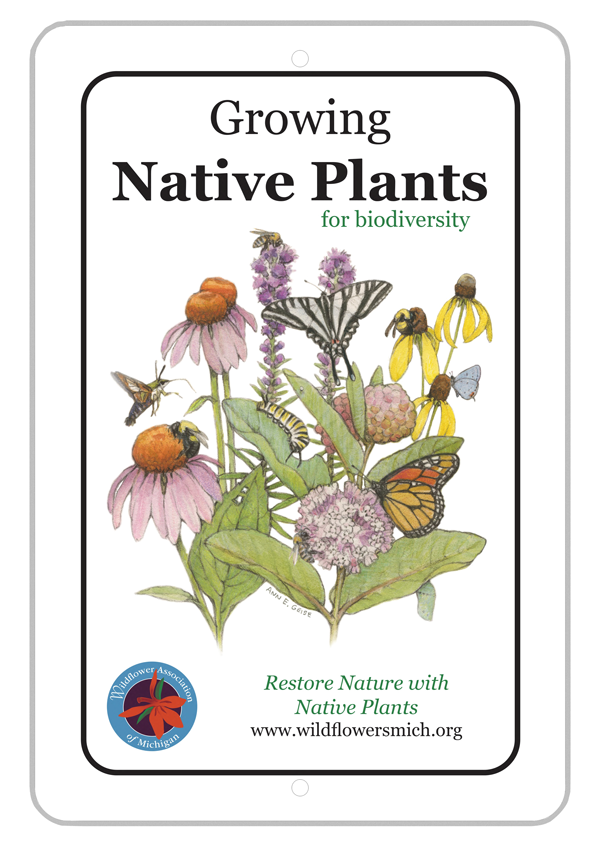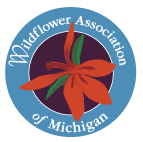
This durable metal sign has two predrilled holes, rounded corners and measures 8×12 inches. Screws not included. Each sign comes with a one-page description of the benefits of native plants to copy and distribute to friends and neighbors.
Native Plant Sign
So, what exactly are Native Plants?
Native plants are those that occur naturally within a defined area. Native plants include trees, shrubs, vines annual and perennials. They have evolved in harmony with the local climate conditions, geology, flora and fauna.
What is Biodiversity?
Biodiversity is the shortened form of two words “biological” and “diversity”. It refers to all the variety of life that can be found on Earth (plants, animals, fungi and micro-organisms). Ecosystems are comprised of all these organisms interconnected in a complex, stable and sustainable network of life. The more species diversity there is in an ecosystem, the healthier and more stable it will be under stress.
Why care about Native Plants?
Of course, native plants are fascinating, beautiful and, by definition, well suited to thrive in the local landscape. But most importantly they serve an essential role in biodiversity. Butterflies, moths, bees and other insects rely on specific native plants for nectaring and as a necessary food source for their caterpillars and larvae. These insects and their larvae sustain local and migrating birds, bats and other wildlife. Native plants are the foundation of biodiversity!
How many Native Plants do I need to make a difference?
Studies tell us that every time that you add a productive native plant to your landscape you improve your local food web. Moreover, woody plants (trees and shrubs) support more wildlife species than herbaceous plants but nectaring plants are necessary for pollinators. The important thing is to get native plants of all types into your landscape. Since most of our suburbs contain around 90% lawn that provides neither food nor shelter, even small additions of native plants benefit wildlife.
How do I start?
Creating a biodiverse landscape with native plants is a rewarding step by step process. Start planting a few natives at a time. Remember it is a work in progress. As you add more plants they will begin attracting butterflies, moths, birds and more! The important thing is to get started. According to author Dr. Doug Tallamy in his book, Nature’s Best Hope, planting “keystone” species (plants that have a “disproportionately large effect on the abundance and diversity of other species in an ecosystem”) is a successful way to start or to add to your native landscape palette. The National Wildlife Federation has a website that provides keystone species for your area just by entering your zip code at www.nwf.org/nativeplantfinder.
Remove Invasive Species
Habitat loss and invasive plants are the leading cause of native biodiversity loss. Invasive plant species spread aggressively and can displace native plants and create monocultures. More information can be found at the Michigan Invasive Species Network www.misin.msu.edu
Nativars and Straight Native Species
Cultivars of native plants are often termed “nativars” (usually a ‘catchy’ name is listed after the species name). They are propagated for aesthetic characteristics such as unique flower and foliage color, flower density or size. These adaptations, however, may reduce their value as a food source by insects. When purchasing plants to create a food web that supports biodiversity, we recommend using straight native species when possible.
Limit use of Pesticides and Herbicides
Through their production, use, and disposal, these compounds adversely affect the rich biodiversity on which life depends; the loss of biodiversity worldwide is well documented. Many of these “cides” — insecticides, fungicides, herbicides and rodenticides – often unintentionally cause harm to wildlife, pets and people. For more information, visit www.beyondpesticides.org
Purchase your Sign and Spread the Word!
By displaying your “Growing Native Plants for Biodiversity” sign you are showing your pledge to making your landscape a nature-friendly environment. It’s a great conversation starter with your friends and neighbors. The more landscapes planted with native plants the more positive the impact on biodiversity.
For more information go to Wildflower Association of Michigan: www.wildflowersmich.org
